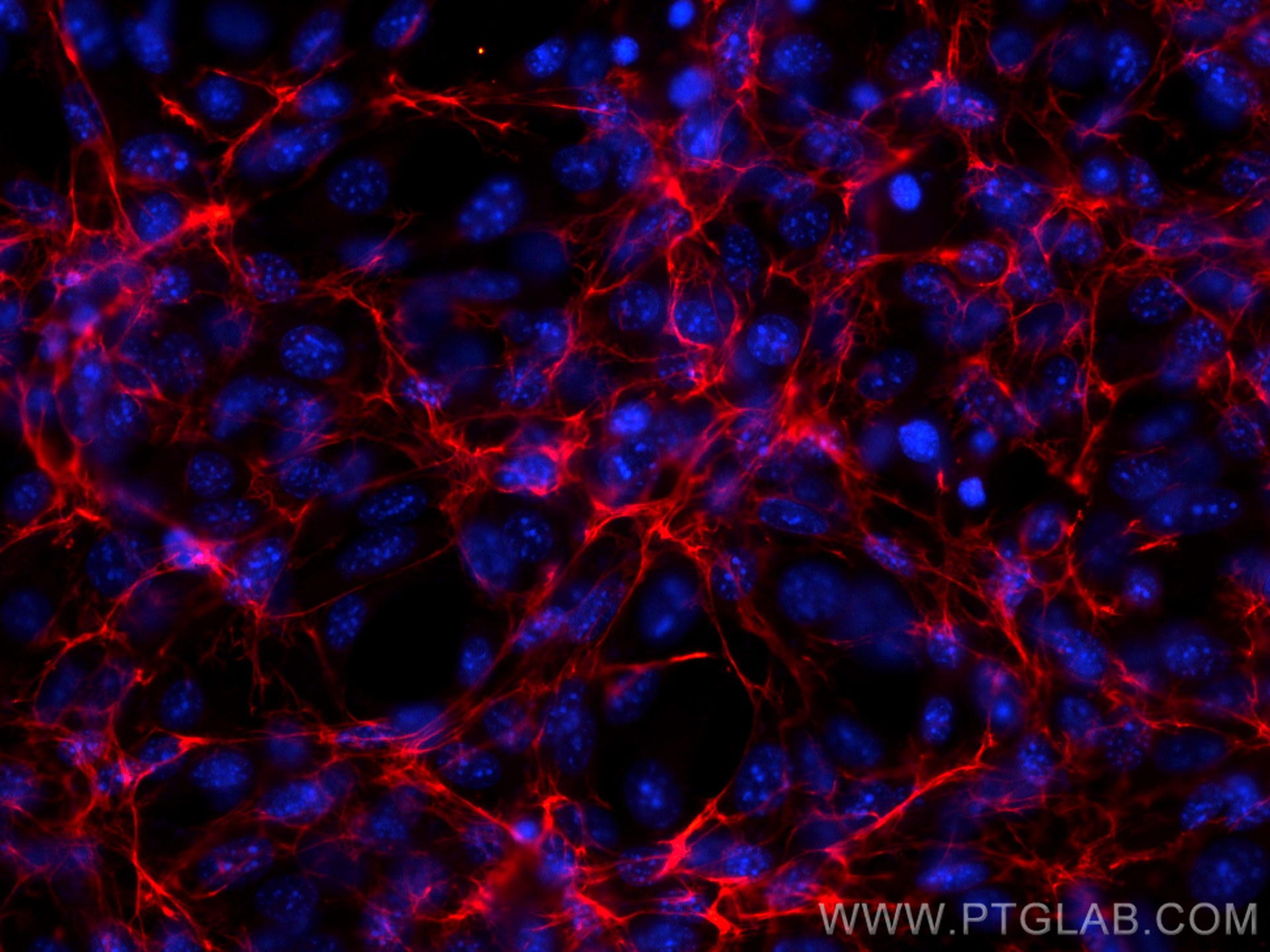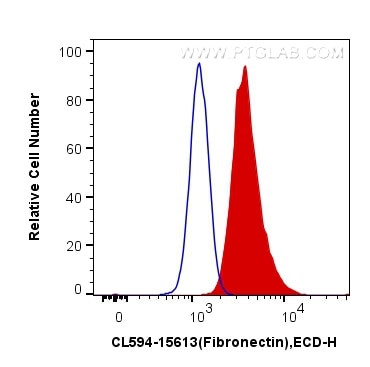- Featured Product
- KD/KO Validated
Fibronectin Polyklonaler Antikörper
Fibronectin Polyklonal Antikörper für IF/ICC, FC (Intra)
Wirt / Isotyp
Kaninchen / IgG
Getestete Reaktivität
human, Maus
Anwendung
IF/ICC, FC (Intra)
Konjugation
CoraLite®594 Fluorescent Dye
Kat-Nr. : CL594-15613
Synonyme
Geprüfte Anwendungen
| Erfolgreiche Detektion in IF/ICC | NIH/3T3-Zellen |
| Erfolgreiche Detektion in FC (Intra) | NIH/3T3-Zellen |
Empfohlene Verdünnung
| Anwendung | Verdünnung |
|---|---|
| Immunfluoreszenz (IF)/ICC | IF/ICC : 1:50-1:500 |
| Durchflusszytometrie (FC) (INTRA) | FC (INTRA) : 0.40 ug per 10^6 cells in a 100 µl suspension |
| It is recommended that this reagent should be titrated in each testing system to obtain optimal results. | |
| Sample-dependent, check data in validation data gallery | |
Produktinformation
CL594-15613 bindet in IF/ICC, FC (Intra) Fibronectin und zeigt Reaktivität mit human, Maus
| Getestete Reaktivität | human, Maus |
| Wirt / Isotyp | Kaninchen / IgG |
| Klonalität | Polyklonal |
| Typ | Antikörper |
| Immunogen | Fibronectin fusion protein Ag8004 |
| Vollständiger Name | fibronectin 1 |
| Berechnetes Molekulargewicht | 2386 aa, 263 kDa |
| GenBank-Zugangsnummer | BC005858 |
| Gene symbol | Fibronectin |
| Gene ID (NCBI) | 2335 |
| Konjugation | CoraLite®594 Fluorescent Dye |
| Excitation/Emission maxima wavelengths | 588 nm / 604 nm |
| Form | Liquid |
| Reinigungsmethode | Antigen-Affinitätsreinigung |
| Lagerungspuffer | PBS with 50% glycerol, 0.05% Proclin300, 0.5% BSA |
| Lagerungsbedingungen | Bei -20°C lagern. Vor Licht schützen. Nach dem Versand ein Jahr stabil. Aliquotieren ist bei -20oC Lagerung nicht notwendig. 20ul Größen enthalten 0,1% BSA. |
Hintergrundinformationen
Fibronectins play a role in cell adhesion, motility, wound healing, and the maintenance of cell shape. Fibronectins bind to cell surfaces via interactions with integrins and various molecules such as collagen, fibrin, heparin, DNA, and actin (PMID: 3326130). Cellular interaction with fibronectin (FN1) promotes cell cycle progression and proliferation by influencing cyclins.
What is the molecular weight of FN1?
The molecular weight of FN1 is 220 kDa.
What is the tissue specificity of FN1?
FN1 is a large glycoprotein that exists in both a soluble form in plasma (plasma FN1) and other body fluids and an insoluble form in the extracellular matrix (cellular FN1) (PMID: 21923916). Plasma FN1, or the dimeric form, is secreted by hepatocytes, whereas cellular FN1, the dimeric or cross-linked multimeric form, is produced by fibroblasts and epithelial cells and deposited as fibrils in the extracellular matrix.
What are the post-translational modifications of FN1?
FN1 is often sulfated and its C-terminal NC1 peptide, anastellin, is produced as a result of proteolytic processing and can inhibit tumor growth, angiogenesis, and metastasis by activating p38 MAPK and inhibiting lysophospholipid signaling (PMID: 11209058).
What is FN1's role in embryogenesis?
Fibronectin has a crucial role in the development of the left-right body axis during embryogenesis (PMID: 21466802).
What is FN1's involvement in disease?
Fibronectin glomerulopathy is a kidney disease that eventually leads to end-stage renal disease and is caused by mutations in the FN1 gene. Mutations in FN1 lead to the production of abnormal fibronectin protein that is deposited in the glomeruli of the kidney (PMID: 18268355).
Protokolle
| PRODUKTSPEZIFISCHE PROTOKOLLE | |
|---|---|
| IF protocol for CL594 Fibronectin antibody CL594-15613 | Protokoll herunterladen |
| FC protocol for CL594 Fibronectin antibody CL594-15613 | Download protocol |
| STANDARD-PROTOKOLLE | |
|---|---|
| Klicken Sie hier, um unsere Standardprotokolle anzuzeigen |



